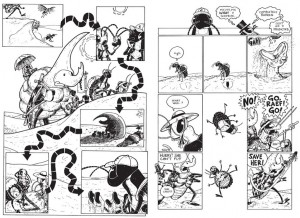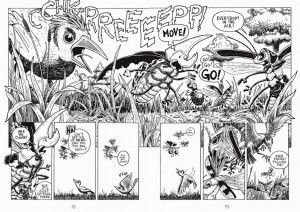This year, the Wildlife Society Northeast Conclave was held by Juniata College at Camp Blue Diamond in Petersburg, Pennsylvania. What is Conclave? You could say it is a conference for students to network professionally and attend workshops about different wildlife related topics or techniques. It is also a fun weekend for like-minded adventure enthusiasts. Even brainiacs have fun participating in the annual Wildlife Quiz Bowl Competition. Altogether, eleven students from our school chapter of the Wildlife Society attended. After helping run events at Paul Smith’s College Conclave last year, I was curious to attend a Conclave put on by another institution.
Before arriving at Conclave, I was a little nervous. Sure, I am a birder and avid outdoor enthusiast, but I am not interested in a professional career in wildlife research or management, like many of the other attending students. I am a biology major and I have a strong interest in environmental education. My goal after college is to work with children and adults and show them why we need to take care of the environment.
So why exactly did I go to something that was basically a gathering of wildlife professionals and students? After working at an environmental education camp this summer, I noticed that wildlife is often the first thing that sparks a person’s interest in conservation. If you asked someone their favorite memory about being in the outdoors when they were young, they usually recall memories of their first interaction with wildlife; often shared with a loved ones or friends. For me, I loved to catch frogs in my grandparents’ backyard. As much as I believe that wildlife conservation is crucial, I do not think that the conservation system is fully effective if the general public is not involved in the process. I want to bridge the gap between the science field and people.
This was not my first event with the Wildlife Society. Last semester, I went to the National Conference in Winnipeg, Manitoba. There my decision to be an environmental educator was solidified when I listened to Richard Louv discuss how we need to reconnect children with nature (“Nature Deficit Disorder”). It was his talk that inspired me to help foster this connection with children and adults. I want to introduce children to the wonders of wildlife of all shapes and sizes. Maybe through wildlife experiences, I could spark their interest in nature. Most of all, I want to help them learn to care about the environment.
At Conclave I attended five workshops. Some of the workshops were about subjects completely new to me, such as electrofishing. Others covered topics that I have already been engaged in for most of my life. First, I went to a workshop on how to guide a nature walk. Here we discussed the difference between interpretation and environmental education. This is an important distinction because I believe that through the process of environmental interpretation, people are able to make their own insights about the environment around them rather than learning from a lecture on facts. Next, I attended a geospatial referencing workshop, which was a completely foreign subject to me. I have not taken GIS at Paul Smith’s because it is not required for biology majors, and I have decided to take electives in the humanities and arts instead. In this workshop, I was shown how use geotagged cell phone photographs as a method of eco-spatial data collection. This is a very accessible way of collecting field data without having to carry around a menagerie of electronics and GPS devices. All you do is take a picture at a location; that’s it. Then, you can place all of the photos on a digital map and use the information tagged to the photograph to learn visual characteristics about a point on a landscape. This technique has several applications in the wildlife field and in environmental education. I also attended a wildlife photography workshop. It would be wonderful if we can combine wildlife photography with the geo-referencing workshop. However, I still believe that photography has an incredible ability to increase awareness of the vast diversity of species and natural systems on the planet; especially those that are in other countries around the world.
My favorite workshop was called “Insect Comics,” which was led by Juniata professor Jay Hosler. Jay is a renowned entomologist and award-winning comic writer. He discussed how comics are a great form of communication and how we can use them to educate the public about wildlife. He even showed statistics on how people can remember images they see more than written information. Then, he had us add our own flair to partially-drawn comics. I loved this workshop because I strive to connect science and art. I think art is a great way to reach out to the public and open an awareness of environmental issues. An example of this technique is using dead or injured wildlife photos to raise awareness about environmental issues.
After attending Conclave, I recognized the importance of building a connection to wildlife. If we don’t develop this connection, the future of human existence on this planet looks dull and colorless. In ode to Smokey the Bear, Only You can Prevent Environmental Destruction. Like myself, it is important that the general public experiences conferences such as conclave. It provides a catalyst for interest in the environment and simultaneously describes easy ways to play an active role in nature. You can be a wildlife technician, photographer, illustrator, educator, habitat restoration specialist, or even someone who enjoys watching birds at their birdfeeder. As long as you stay connected with wildlife in a positive way, you are helping conserve wildlife long term. Eventually, these connections you develop may get passed on to your loved ones and friends. It is in this process that environmental consciousness will continue to exist in our society.
While you are a student here, joining the Wildlife Society is a great way to develop your interest in wildlife. Who knows, it may open up new ideas, career opportunities, or just enhance your lifestyle. An interest in wildlife should be universal, and not strictly for the wildlife professional. Take an interest in wildlife in any way you can, because there are so many ways to stay connected with nature.

Bianca Fournier is a senior in Biology at Paul Smith’s College. She is a runner, yogi, birder and loves to ramble about the woods. When she is not exploring outside, she loves to paint watercolors of wildlife.



